If you own cast iron this guide will teach you How To Season a Cast Iron Skillet so your skillet is seasoned perfectly for cooking and baking.
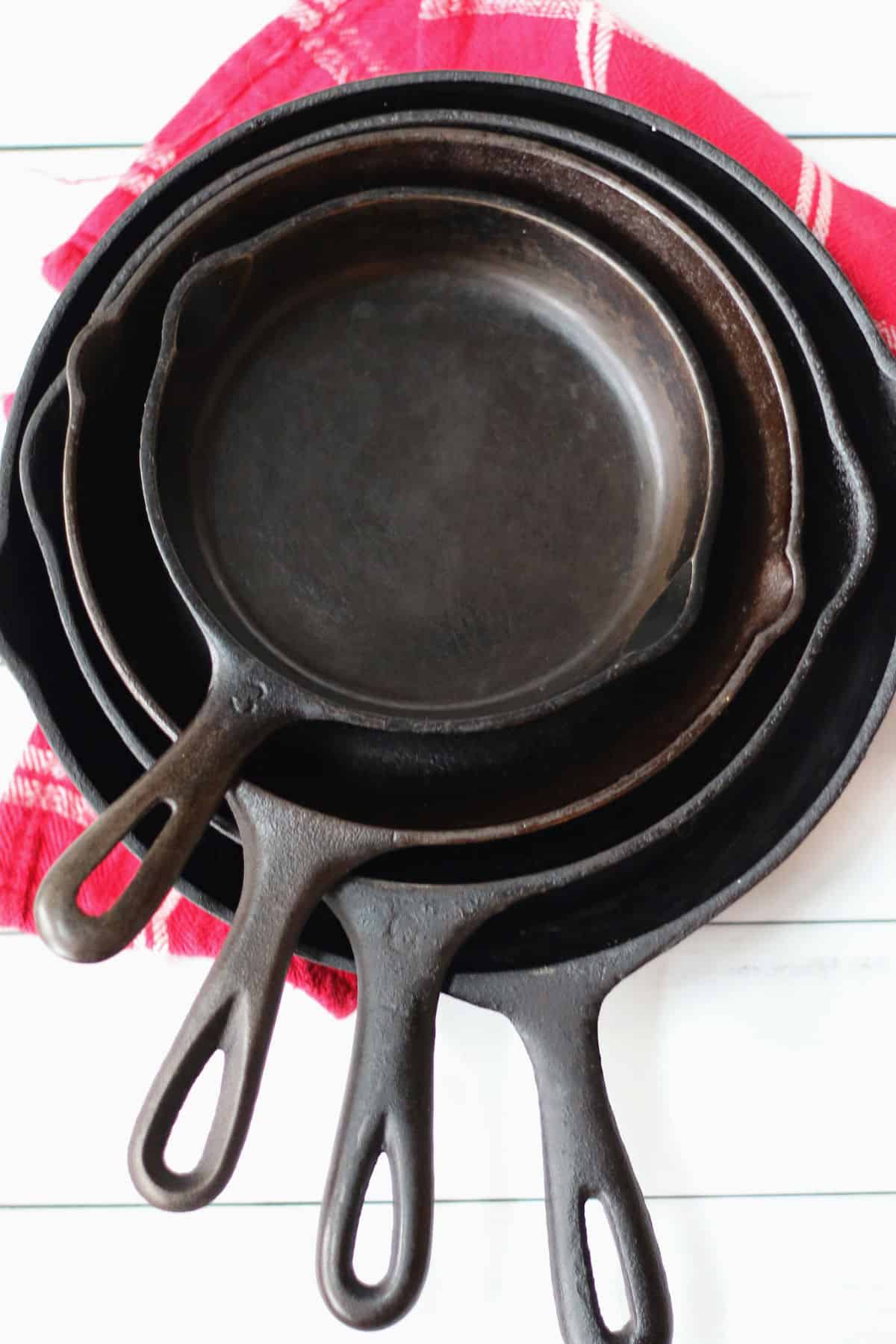
Want to save this recipe?
Enter your email & I'll send it to your inbox. Plus, get great new recipes from me every week!
This page may contain affiliate links, please see my disclosure for policy details. I earn commissions if you shop through the links on this page.
During a thrift store trip, I found a $5.00 Lodge Cast Irion Skillet. Score, another skillet to add to my collection! You can find cast iron skillets in almost any thrift store for next to nothing, so guess what, they are a cheap investment for your kitchen, but they are probably not in the best shape.
There are so many reasons to use cast iron, they are so versatile for both cooking and baking and will last a lifetime. I am still using my grandmother's Griswold iron skillet from the 1940s. It has had a lot of fried eggs cooked in it. And also her favorite Vanilla Skillet Cake and Maple Apple Skillet Cake, both are easy to make and tastes amazing.
Jump to:
The how's and why you need to season cast iron?
- Cast iron cookware is basically large pieces of metal shaped into different shapes and sizes.
- Think of seasoning cast iron cookware as curing the finish.
- There are actually two steps to this process that are a bit scientific, but don’t let that scare you away.
- The first step is called “polymerization” which is coating the cast iron with a thin layer of oil
- The second step is called “carbonization” which is heating the oiled cookware at a high temperature to create
- a reaction with the oil that bonds with the metal resulting in a beautiful shiny black patina. Yep, scientific!
- This process is basically baking multiple coats of oil on the cookware.
- If you don’t season a pan your food will stick and over time will rust.
- The best oil for seasoning cast iron is an unsaturated vegetable oil like canola, grapeseed, flaxseed, corn, or safflower oil
- Using other oils can cause the cast iron to become sticky after the baking process, so stick with these oils
- However, my grandmother just used Crisco or lard to season her pans and they were beautiful.
- Do not use olive oil or butter since they have low smoke points.
- Use a very thin layer of oil - using too much will hamper the carbonization process during baking. Make sure to wipe off the oil with a clean cloth, after doing this it will look like you wiped all the oil off, but a very thin layer is still there.
- Put the oiled pan in a 450-degree F oven. Do not put it in a cold oven and let heat up.
- Once a pan is properly seasoned it should have a shiny nonstick surface.
- Each time you use your cast iron cookware and add oil to it, the oil will penetrate into the cast iron and condition the cookware even more. Over the years of use, you will see a smooth surface. See notes on new cast iron with pebbly or grooved finishes.
- Acidic foods such as tomatoes can ruin the seasoning on cookware. If you do cook with these foods just reseason the cookware. A really good seasoned cast iron can handle a little bit of acidic foods. I wouldn't cook a batch of marinara
- Certain new cast iron cookware comes preseasoned, but some are just mildly seasoned. Always add a new layer of seasoning before using to get ready for cooking.
- Also, many of the new cast iron cookware has a grooved or pebbled finish which will remain that way.
- Keep your pans dry because cast iron does not like water, and you won’t like a rusted pan.
Why use an iron skillet
- You can cook and bake in a cast-iron
- It's perfect for moving from the stovetop to the oven
- You can set cast-iron over open flames like a campfire or on a grill - it can handle high heat
- Cast iron retains heat and radiates heat better
- Use an iron skillet for the perfect sear on meat, the skillet handles high heat well and creates a nice sear
- These pans are pretty much indestructible, just keep them seasoned!
Are cast iron pans really nonstick?
They are and they aren't. In order for cast iron to be considered nonstick, the pans have to be seasoned really well, heated up before food is added and some oil added before use. They are not even close to the new Teflon-type pans that don't require any oil, but then again you don't get the great benefits of cast iron.
So back to my thrift store find. This is a Lodge skillet and it doesn't look like it has been used for a while so it definitely needs some TLC; it has a lot of rust on the front and back and the seasoning is gone. No way can I fry an egg in this pan.
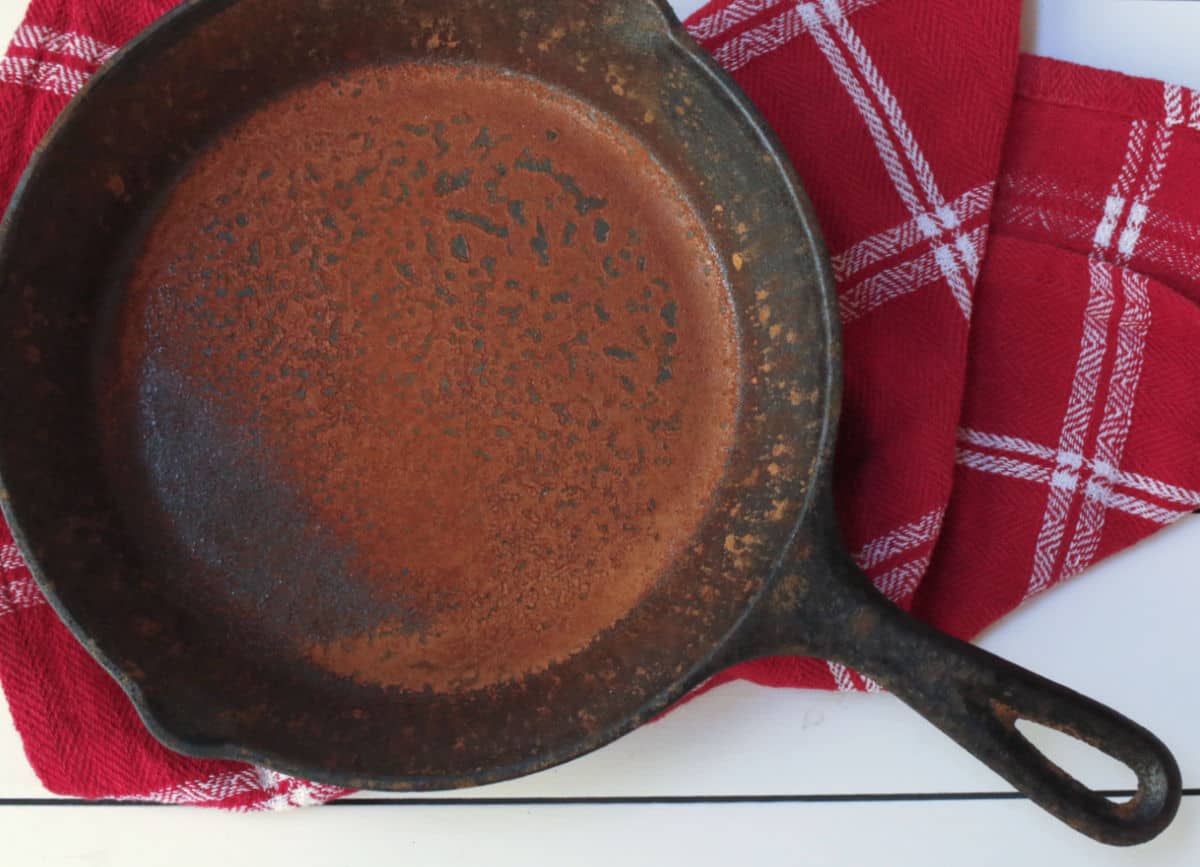
Bringing this skillet back to life just takes a few easy steps to get that lustrous shiny black patina. It’s not hard to do!
How to season cast iron
Step 1. Prep steps - Preheat the oven to 450 degrees. You will need dish soap and a scouring sponge or pad.
Step 2. Thoroughly wash the skillet with warm soapy water, scrubbing with the scouring pad. Rinse and repeat until the skillet is free of any rust or cooked on food.
Step 3. Thoroughly rinse and dry the skillet
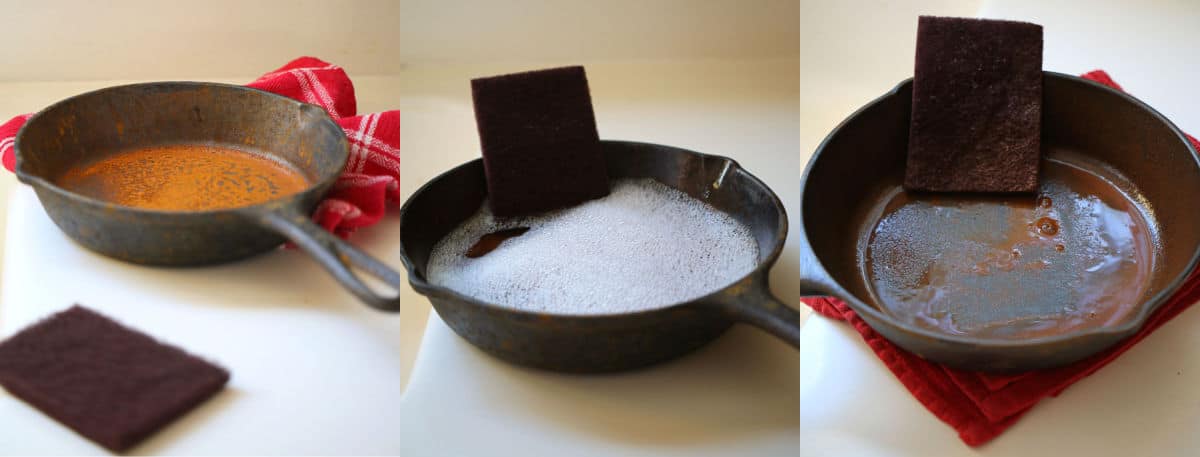
Step 4. Pour oil into the skillet (I use canola oil).
Step 5. Using a paper towel or a soft rag, wipe the oil all over the front side of the pan, including the handle.
Step 6. Turn the skillet over and wipe more oil all over the bottom and sides of the skillet.
Step 7. Take a dry paper towel or rag and go all over the skillet to remove any excess oil or drips. Too much oil will cause the pan to be sticky. You want a very fine layer of oil.
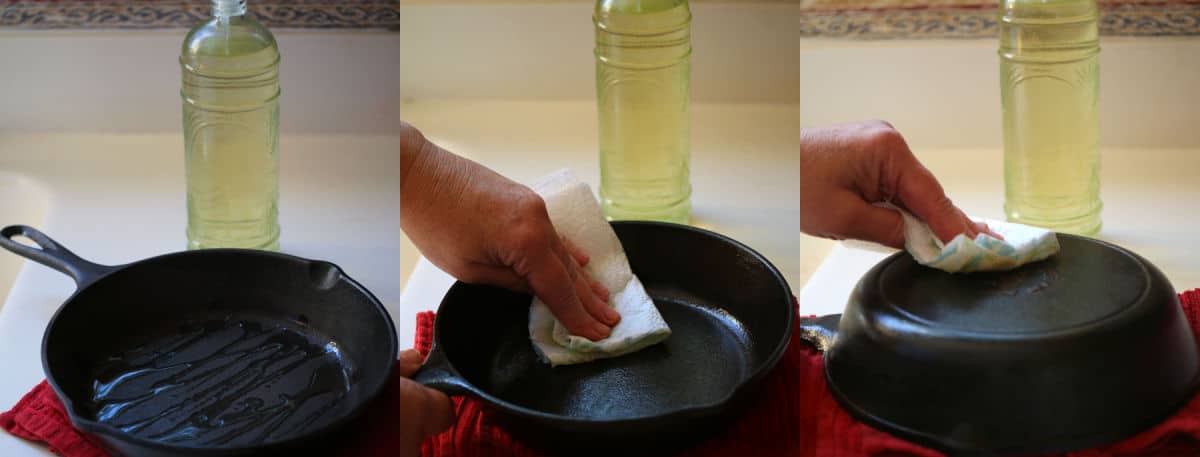
Step 8. Put a sheet pan on the bottom rack of your oven, or you can use a large piece of foil, this will catch any drips that might occur from the oil. Place the oiled skillet upside down on the upper oven rack. Bake for 1 hour.
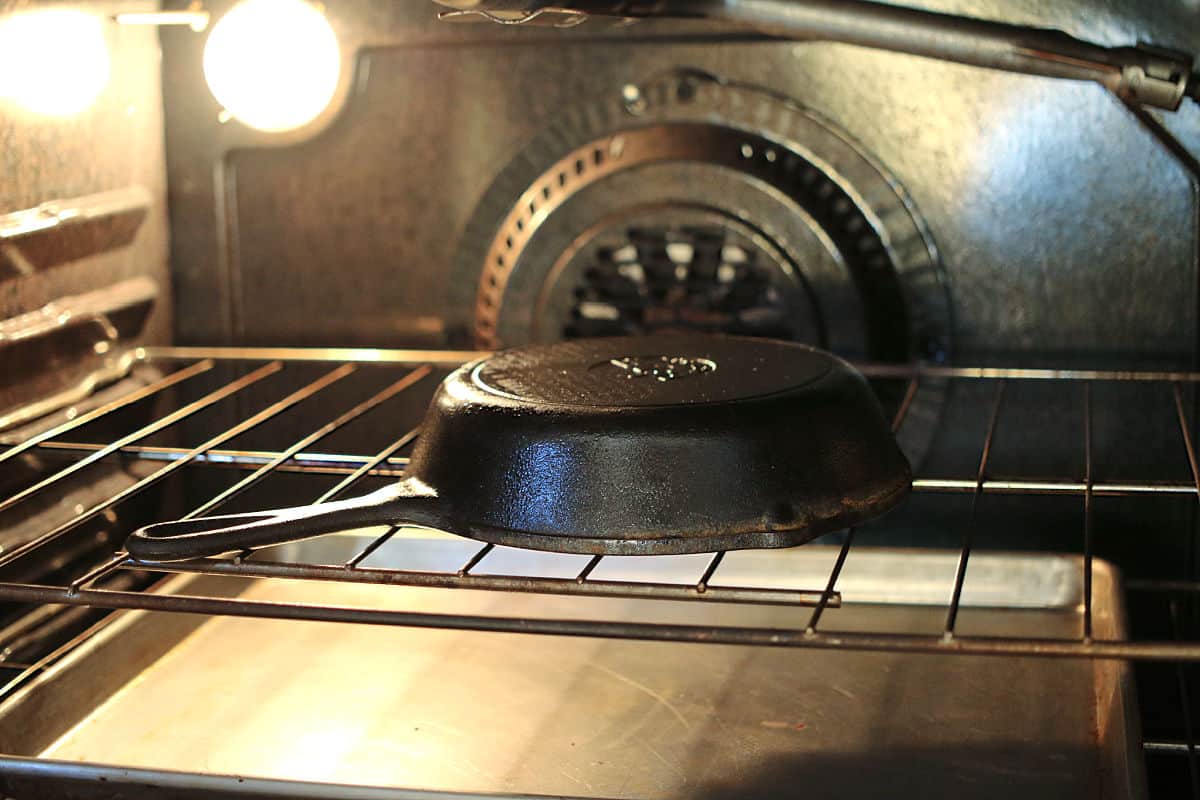
Step 9. After an hour, turn the oven off and let the pan cool in the oven.
Step 10. For new and vintage pans that really need a good seasoning, you may need to repeat the oiling and baking process 2 or 3 times. Let the pan cool in the oven and repeat oiling the pan, wiping off all the excess oil, and place back in the oven for an hour. This ensures a good seasoning. The better your cast iron is seasoned the more it achieves its nonstick surface
That's it, you are done and your skillet is nice and seasoned. No more rust!
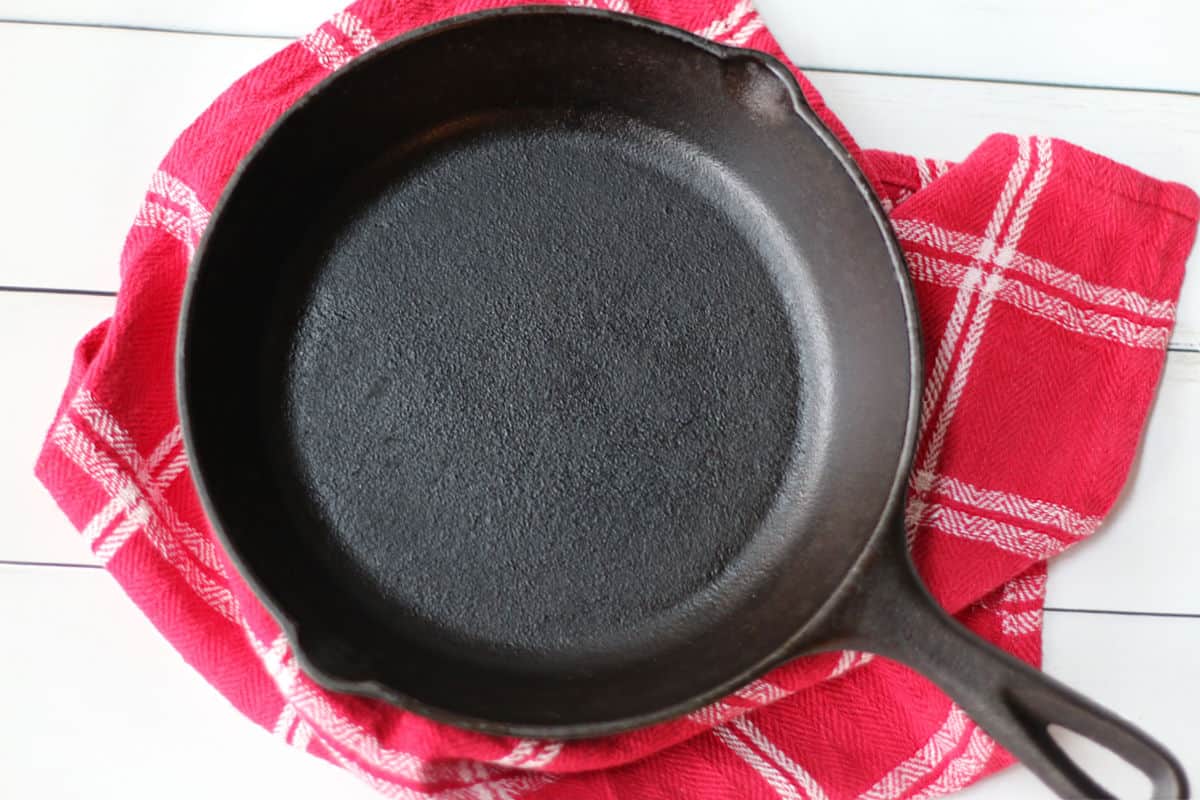
Thrift store vintage skillets
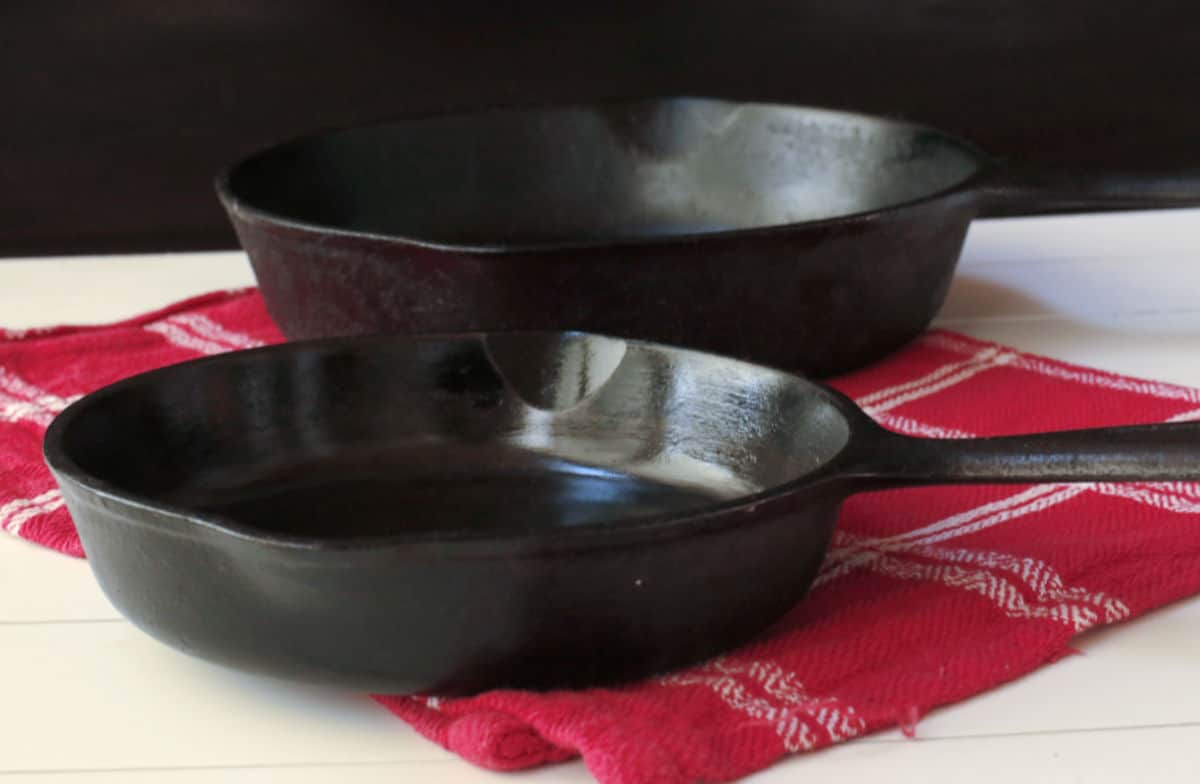
Here are two other thrift store finds that get a lot of use. The round griddle is used for pancakes and grilled cheese sandwiches and the square pan is used for cornbread and cakes.
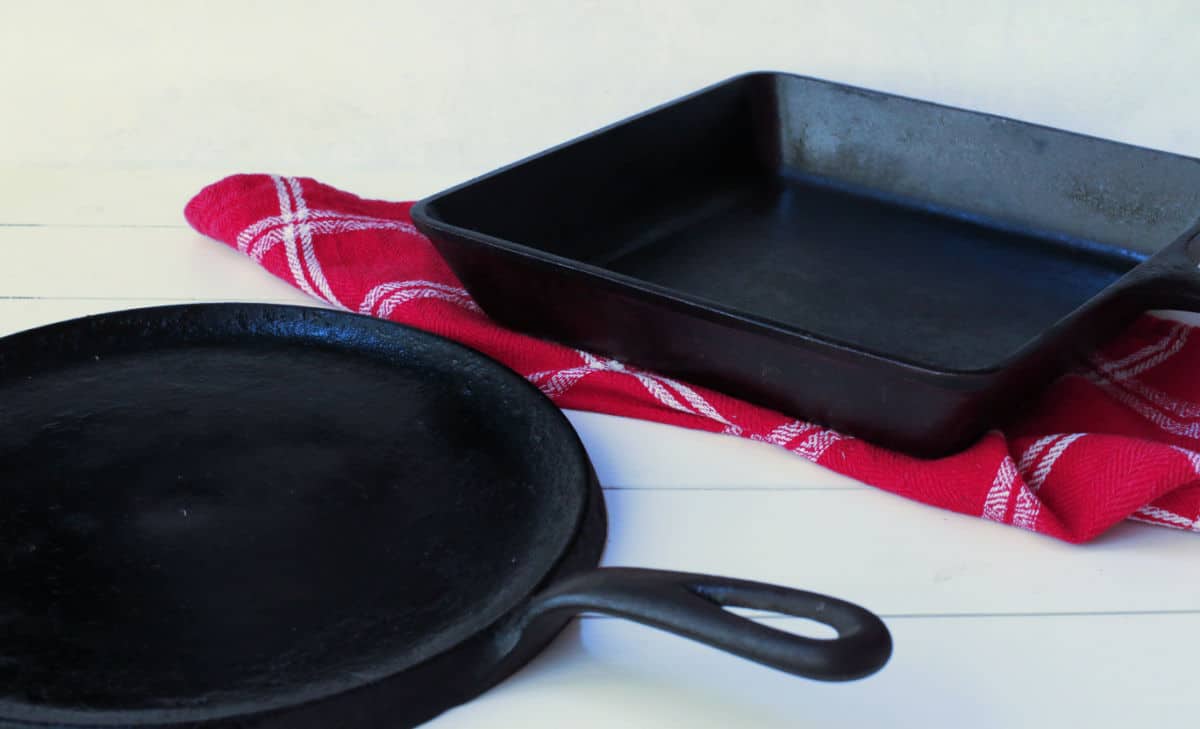
What is the best way to clean cast iron?
A well-seasoned pan can handle a little soap (really I mean a drop) when cleaning and if seasoned well, the pans should clean easily.
Step 1. Scrap any leftover food out of the pan when done using. I use these Lodge plastic scrapers.
Step 2. Before your cast iron totally cools off, wash with warm water and very little soap, and use a plastic scouring sponge to clean the pan. If you have bits of food that do not come off, pour some salt into the pan which acts as a gentle abrasive, then wipe with a paper towel.
Step 3. Rinse with water.
Step 4. Dry the pan completely. You can place the pan over a hot burner to dry it out
Step 5. Lastly, wipe the cast iron with a little bit of oil and then store it in a dry place. I oil the inside after each use and the outside when I feel it needs some attention.
Step 6. About every six months, I reseason all my pans to maintain the proper seasoning.
Some things not to do
- Do not let your cast iron sit in soapy water, clean it as soon as possible
- Never put your cast iron cookware in the dishwasher
- Abrasive cleaners and sponges will remove the pans seasoning
If you are wanting a new skillet this Lodge 8' skillet is what I have shown here being cleaned and seasoned. Don't forget the rubber scrappers, I used these all the time and they come in handy for cookware and bakeware for getting stubborn stuck-on food off.





There, I think we covered everything, now it's time to use this newly seasoned skillet for something delicious. Do you have a favorite recipe you use cast iron for, I would love to share it here on One Hot Oven?
First published: Nov 29, 2015, Last updated: Oct. 10, 2022 for better readability.
Follow One Hot Oven
Like what you see? Make sure you are following One Hot Oven for more tasty sweet and savory recipes!
Thank you for stopping by the One Hot Oven blog. Please leave a comment to say Hello or just let me know what you are baking these days, I always love hearing from fellow bakers. Have any questions or just want to chat about the recipe? Please visit my about page for information, and I’ll be happy to help!
About Jere’
From learning to cook on a farm in Indiana to culinary school in California, my passion for food is never-ending. Turning on my oven to bake something for friends and family is my happy place, and I am glad to be here at One Hot Oven sharing both sweet and savory family-friendly recipes for your cooking and baking inspiration.
Pinterest |Instagram | Facebook | Twitter |



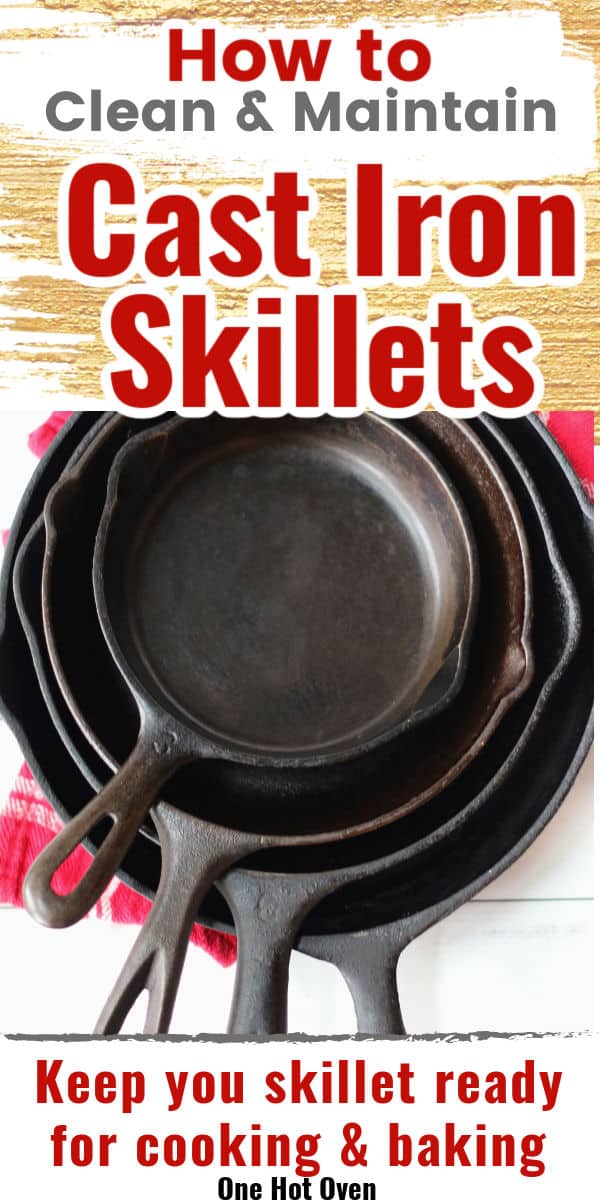
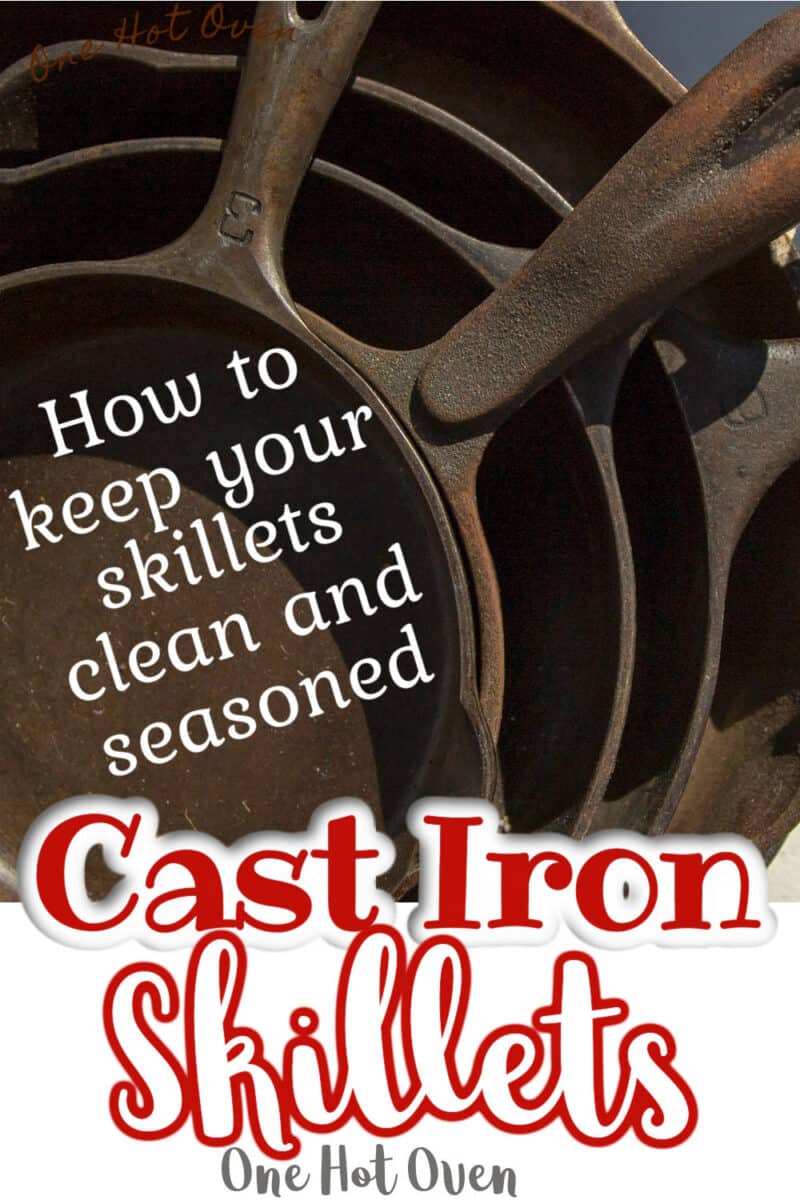
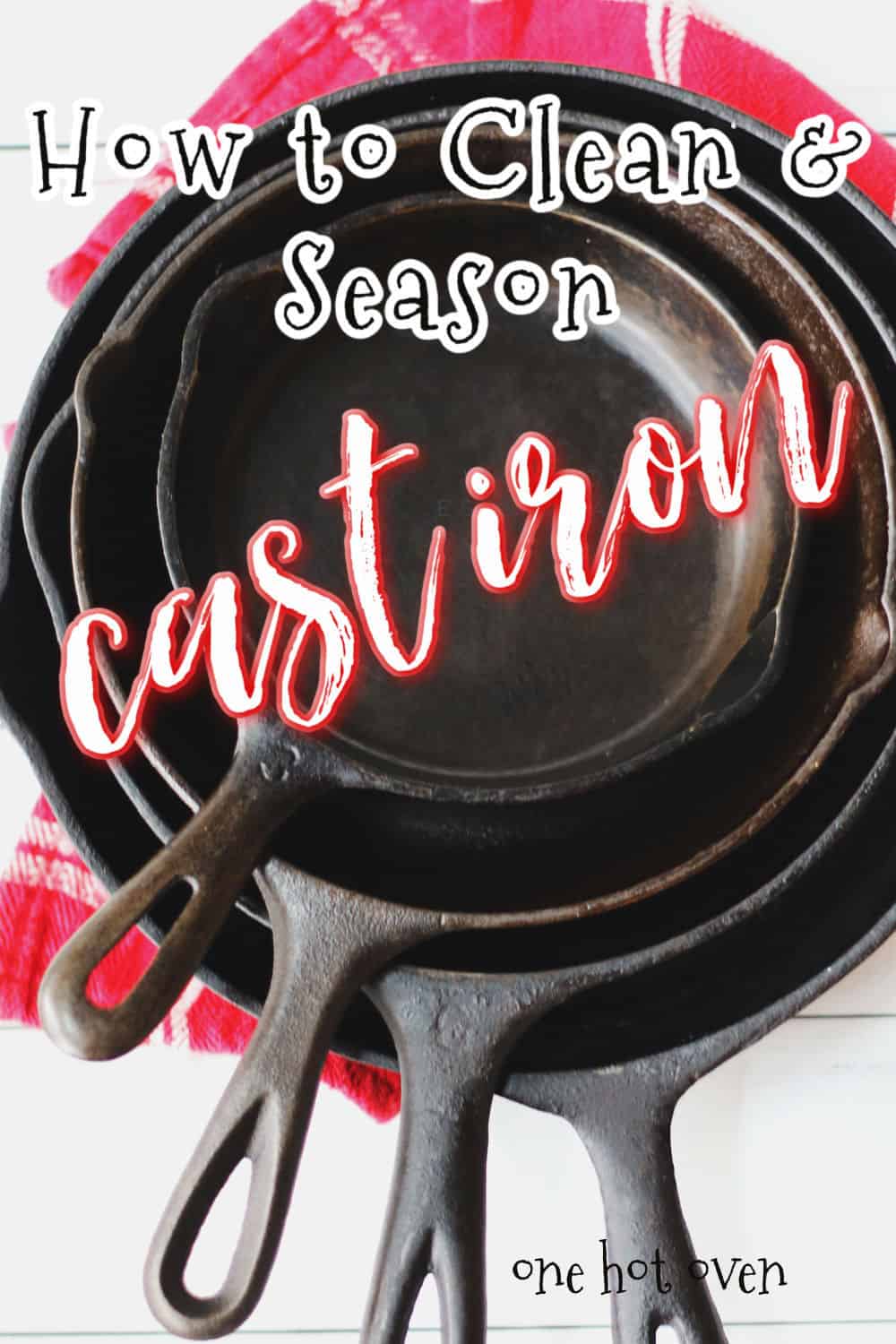

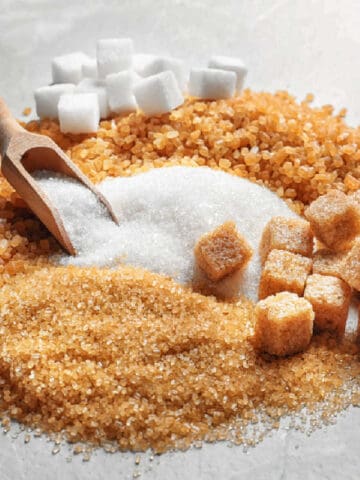
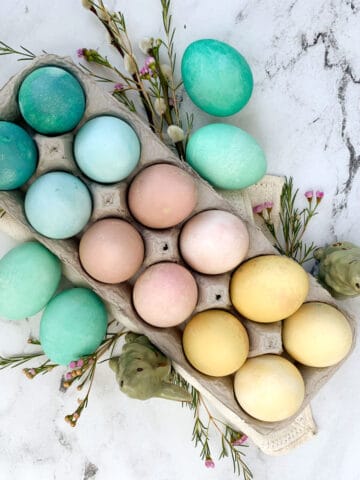
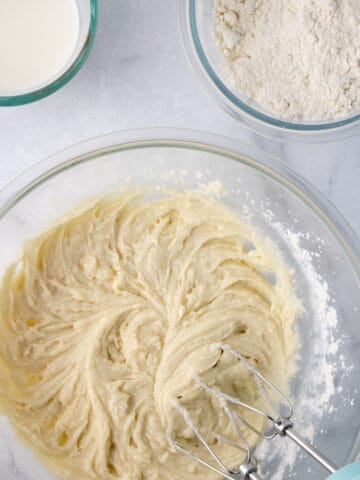

Tommy Howard
I just now getting into using cast iron. This article is really user friendly. Can’t wait to try it out.
Thanks
TL Howard
Natalie
Iron skillet requires special treatment. I was looking for tips, and I'm glad I found your article. Thanks! I now realize it's easier than I previously thought.
Jere Cassidy
True, it's not hard. It is amazing over the years to see the seasoning on the skillet form.
Dee
I had no idea I need to season a cast iron, this information is a game changer and I can’t wait to check out my local thrift store.
Stine Mari
You have so many great tips in this post! I'm going to try this with my old cast iron skillet, your thrift store find turned out perfectly.
Jere Cassidy
It did and now I am kinda obsessed with finding skillets to clean up.
Amy Liu Dong
These are great and definitely helpful tips. I am going to clean my skillet now and cook our delicious dish. Thank you!